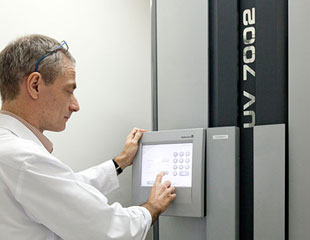WHAT IS NB-UVB PHOTOTHERAPY?
Ultraviolet (UV) rays are produced by the sun and are grouped into different wavelengths. UV radiation is an important part of sunlight and is divided into ultraviolet A (UVA) and ultraviolet B (UVB) wavelengths. UVA rays go deeper into the skin and cause the skin to tan. UVB rays do not penetrate as deeply but can cause the skin to burn.
Narrowband UVB (NB-UVB) is a particular treatment where a small part of the UVB light spectrum is used to treat a skin condition. Treatment lamps produce these special rays, which have anti-inflammatory effects on the skin. Although these rays are also present in natural sunlight, NB-UVB treatment is usually more effective than sunlight because harmful and ineffective sunlight rays are filtered out. In this way the risk of burning is minimised.
Phototherapy is given by standing in a cabinet where the whole body is exposed to NB-UVB.
NB-UVB phototherapy must be carried out in hospital under medical supervision; it will be necessary for you to attend 2-3 sessions a week, on non-consecutive days. The length of treatment varies depending on the skin condition: 7 to 10 weeks for psoriasis, several months for vitiligo.

WHAT CONDITIONS ARE TREATED WITH NB-UVB PHOTOTHERAPY?
NB-UV phototherapy has been found to be useful for many different skin conditions, the most common are psoriasis, eczema and vitiligo.
ARE THERE ANY OTHER TYPES OF PHOTOTHERAPY?
The main other phototherapy treatment is PUVA (Psoralen + UVA), where UVA radiation is combined with a chemical called psoralen that increases the effect of UVA on the skin.
It is also possible to combine NB-UVB and UVA (without taking psoralen).
The choice of phototherapy depends on your skin condition. Your doctor will tell you which treatment is best for you.
WHAT ARE THE POTENTIAL SIDE EFFECTS OF NB-UVB PHOTOTHERAPY?
- A sunburn-like reaction (most often because individual sensitivity or by concomitant intake of a medication-inducing photosensitivity taken without informing your doctor).
- Itchy skin.
- Skin dryness (this can easily be helped with moisturizing creams).
- Tanning of the skin. This will fade over a few months after finishing treatment.
- Cold sore (herpes).
- Premature ageing changes in the skin (e.g. dryness, freckling and wrinkling) may occur in patients who have had multiple courses of phototherapy for many years. Also they may have a slightly increased risk of developing skin cancer in later life. Your doctor will have your skin type assessed and will discuss this as part of your consent process. Safe lifetime doses are monitored in the department.
- Deterioration of the disease being treated. This may occur instead of improvement and your doctor will advise you of the risk of this happening.
WHICH PRECAUTIONS SHOULD BE TAKEN?
Before treatment
- Do not apply perfume, deodorant, aftershave lotion, other cosmetic products, cream or ointment to your skin within a few hours before your treatment as these may make your skin more sensitive to the ultraviolet light.
- Do not drink alcohol.
- Tell your doctor or nurse if you have been taking any new medication and if you have developed excessive discomfort or redness of the skin following prior phototherapy session.
During treatment
- Your lips should be covered with a sun block prior to NB-UV phototherapy.
- You will be given goggles to protect your eyes, which you must wear at all times during your treatment.
- If you have spots on your scalp that need treatment, cut your hair as short as possible. If impossible, use hairpins to expose the spots for treatment.
- If you don’t have spots on the face or the neck, protect these areas with a scarf and sunblock cream.
- It is important that clothing is not worn whilst undergoing treatment in the light cubicle (except male patients, who must wear a protective covering to the genital area). If you wear clothing during treatment to protect some parts of your body it is important that you wear the same clothing during each session.
- You will be in the UVB machine for up to 15 minutes. A nurse will closely monitor the amount of UVB you receive and will increase the dose with each treatment as long as you have well tolerated the previous treatment.
- Stay in the middle of the treatment cabin and do not move around during treatment.
After treatment
- Throughout the course of your treatment, you should not sunbathe or use a sun bed at any time.
- Do keep your skin covered and use a high SPF sunscreen on exposed skin (such as face and hands) when you are outside or when you are exposed to sunlight through window glass.
- Do not have a haircut during the whole course of your treatment. This is to prevent burning of areas which were previously covered by hair, such as your neck, forehead or ears.
- NB-UV phototherapy results can take a while to appear. Most people will see improvement only after 10-20 treatments.
For the treatment to be effective, it is important to attend sessions regularly. If you are unable to attend for treatment, yourself or a relative should telephone the medical secretary.



